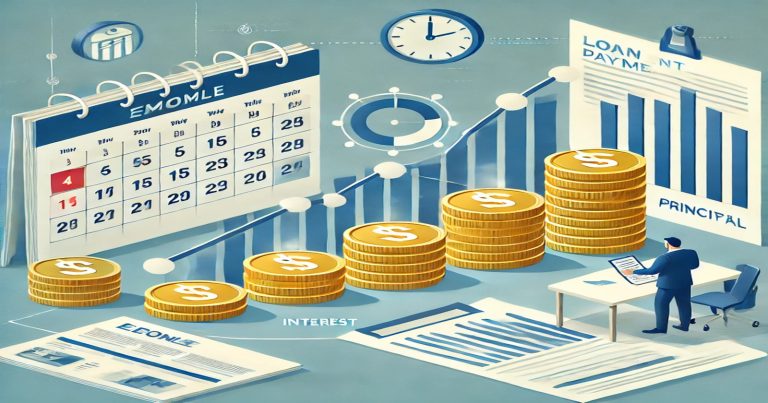Amortization is the distribution of the cost of an asset or loan over its useful life or term. It’s essentially spreading out the expense of something over time. For instance, when you take out a mortgage or a car loan, the loan is amortized, meaning you pay it off in regular installments over a set period.Amortization refers to spreading out a loan repayment over time in smaller, manageable installments. Each part includes interest and principal. The amortization example of a Rs 100,000 loan helps understand this process. For example, when someone borrows Rs 100,000 at 5% interest for 10 years, they pay equal amounts monthly. Each payment will reduce both the loan and interest. This method helps in managing finances without stress. Students, workers, and business owners can benefit from learning this. It shows how debts go down slowly every month.
How to Create a Loan Amortization Schedule?
Creating a loan amortization schedule is essential for every borrower. It helps track how much money is paid each month. The schedule splits each monthly payment into interest and loan parts. This keeps a record of how much is spent and how much is left. People use this method in business loan amortization, home loan amortization, and car loan amortization. When someone pays on time, the schedule keeps reducing the remaining balance. Over time, the interest part becomes smaller and the loan part becomes bigger. This section shows how to create a complete schedule in simple steps.
Process to Create an Amortization Schedule
To begin the process, write down all the loan details like amount, interest rate, and term. This helps set a base for further calculation. Suppose someone borrows ₹10,00,000 at 8% interest for five years. This is a typical setup in many home or business loans in India. One should also know whether the payments are monthly or yearly. Monthly payments are more common because they are easier to manage.
Now, calculate the EMI using the correct formula. The amortization formula is needed here to find the proper monthly payment. It looks like this:
EMI=P×r×(1+r)n/ (1+r)n−1
Where:
- EMI = Equated Monthly Installment
- P = Principal loan amount
- r = Monthly interest rate (annual rate ÷ 12 ÷ 100)
- n = Total number of monthly payments (loan term in months)
Once the EMI is calculated, the next step is to break it into interest and principal. The interest part is always higher in the beginning. This is because the interest is charged on the full loan amount. As months pass, the interest reduces because the loan amount becomes smaller. The rest of the EMI goes toward the principal.
For example, in the first month, the EMI is ₹20,276. The interest is ₹6,667. The remaining ₹13,609 goes to reduce the loan. So the balance becomes ₹9,86,391. Next month, interest will be charged on this new balance. This pattern goes on till the loan is fully paid.
The borrower can also add extra payments if they want. This is called an amortization schedule with additional fees. These payments reduce the balance quickly and save interest. Some people make a few large payments during festivals or after getting bonuses. It is a smart way to save money and become debt-free faster.
Amortization Table and How It Works?
An amortization table is a list that shows all monthly payments in detail. Each row tells how much interest and principal are paid that month. This table is a helpful guide for people who want to track loans. Many students and first-time borrowers find this table easy to read. It shows how loans are reduced step by step. The table also helps understand how long the loan will take to finish. People often use this with tools like the amortization calculator with principal and interest, or the mortgage amortization calculator.
Breaking Down the Monthly Payments
Every row in the table shows the total EMI, the interest, the principal, and the remaining loan. In the beginning, interest was high. This is because the loan is still large. Over time, the interest goes down, and the loan is reduced faster. This pattern is followed in amortized cost example loans and all types of repayment schedules.
As months go by, the share of principal increases. This means more of the actual loan gets paid. It helps reduce the overall debt slowly but surely. The borrower can check this table every month to see the progress. The table is helpful in planning. It helps people know when they will be free of the loan. If someone wants to prepay, they can see how much interest they will save. This makes the amortization table an essential tool in financial planning. Many people keep a soft copy of the amortization schedule in an Excel file. It helps update changes and track real-time payments. Some even use mobile apps or web tools to keep their table ready. These tools make it easier to plan monthly budgets and avoid loan shocks.
Amortization Table vs. Loan Repayment Calculator
The amortization table is a long list that shows payment splits. A loan repayment calculator gives only totals like EMI and interest. The calculator is quick. It helps when someone wants to decide whether to take a loan. But it does not show monthly breakdowns. The table is better for people who want to understand how their money works. The mortgage principal and interest breakdown comes from this table. Homeowners can see how much of the loan is left. They can also check if they are paying more interest than principal. The table gives a complete picture of the loan journey.
Amortization Example: Breaking Down a Rs 100,000 Loan
The amortization example in this section shows a Rs 100,000 loan over 10 years. It helps explain everything in straightforward steps. People in India who are taking loans for business or homes can relate to this. Many people take loans to buy a flat, a car, or set up a new business. So this example fits many real-life needs.
Loan Details and EMI
In this case:
- Loan = Rs. 100,000
- Rate = 6% per year
- Term = 10 years or 120 months
- Monthly rate = 0.5%
Step 1: EMI Formula
EMI=P×r×(1+r)n/ (1+r)n−1
Step 2: Plugging in the values
EMI=(100,000×0.005×(1+0.005)120/ 1+0.005)120−1
First calculate:
1+0.005=1.0051 + 0.005 = 1.0051+0.005=1.005
(1.005)120≈1.8194
EMI=100,000×0.005×1.8194 / 1.8194−1
EMI =Rs 1,110.21
EMI ≈ ₹1,110 per month.
The EMI stays fixed each month. It helps the borrower plan better. The loan gets paid slowly, month by month. Over time, the loan balance reduces.
Loan Amortization Schedule
| Month | EMI (₹) | Interest (₹) | Principal (₹) | Balance (₹) |
| 1 | ₹1,110 | ₹500 | ₹610 | ₹99,390 |
| 2 | ₹1,110 | ₹497 | ₹613 | ₹98,777 |
| 3 | ₹1,110 | ₹493 | ₹617 | ₹98,160 |
| 4 | ₹1,110 | ₹491 | ₹619 | ₹97,541 |
| 5 | ₹1,110 | ₹487 | ₹623 | ₹96,918 |
| 6 | ₹1,110 | ₹484 | ₹626 | ₹96,292 |
Every month, the interest reduces. The principal increases. The loan comes down slowly at first, but faster later. This is how monthly amortization works.
Over 10 years, this pattern will repeat. The borrower will pay around Rs 33,225 as interest. That’s why early payments help save money. Many people use a mortgage amortization calculator to check these values quickly. It helps decide if the loan term is good or needs to be changed.
Common Mistakes to Avoid When Calculating Amortization
When calculating amortization, people make mistakes that cost money. These mistakes delay loan closure and increase the interest amount. Learning about these common mistakes helps save both time and money. Borrowers can use this knowledge to avoid stress and finish loans faster. They can plan better and use tools correctly. Many of these mistakes happen due to a lack of awareness or the wrong use of a calculator.
Not Adding Extra Payments
Many people don’t pay anything beyond EMI. However, the loan balance drops quickly when they pay more, which is called an extra payment. These payments also reduce interest. People can add bonuses, tax refunds, or additional income as extra payments. This is the benefit of using an amortization schedule with extra payments. It shortens the loan term and saves thousands in interest.
Confusing EMI with Total Loan Payment
Some think EMI only reduces the principal. But EMI includes both interest and principal. In the early years, most of it is of interest. This leads to confusion. Knowing the interest amortization part is essential. Without it, one might believe the loan is not reducing. The principal amortization increases only after some time. This is common in all amortized loans.
Picking the Wrong Loan Tenure
Choosing 20 years instead of 10 years may look cheaper monthly. But it increases total interest. Many borrowers pick long terms for lower EMIs. This is good for low-income people. But in the long run, it costs more. Using a loan repayment calculator helps compare total costs. That’s why tenure must match income level and repayment capacity.
Not Using Digital Tools
Some people calculate EMI manually. This leads to errors. Others ignore tools like an amortization calculator with principal and interest, or a mortgage amortization calculator. These tools give exact results. They save time and help avoid wrong payments. Mobile apps also help track missed EMIs or upcoming dues.
Not Maintaining a Table
Some borrowers don’t track their amortization table. They rely only on bank messages. If a mistake happens in the bank system, they won’t know. Keeping an amortization schedule in Excel helps match with bank records. This builds trust and gives control. Updating it monthly keeps the borrower informed and safe.
Relevance to ACCA Syllabus
Amortization is closely linked with financial reporting and asset management under the ACCA syllabus. It is essential to interpret how intangible assets and other long-term costs are systematically expensed over their useful life. Knowledge of amortization supports accurate preparation of financial statements and analysis, which are core to ACCA exam success and career relevance.
Amortization Example ACCA Questions
Q1: What does amortization typically apply to in financial reporting?
A) Tangible assets
B) Liabilities
C) Intangible assets
D) Inventories
Ans: C) Intangible assets
Q2: Under which standard is the amortization of intangible assets primarily guided?
A) IAS 2
B) IAS 38
C) IFRS 15
D) IAS 16
Ans: B) IAS 38
Q3: If an intangible asset is amortized over 5 years using the straight-line method, what is the annual amortization expense for an asset worth Rs 100,000?
A) Rs 10,000
B) Rs 15,000
C) Rs 20,000
D) Rs 25,000
Ans: C) Rs 20,000
Q4: Which financial statement shows the accumulated amortization?
A) Income Statement
B) Cash Flow Statement
C) Statement of Changes in Equity
D) Statement of Financial Position
Ans: D) Statement of Financial Position
Q5: Amortization affects which financial metric the most?
A) Revenue
B) Equity
C) Net profit
D) Operating margin
Ans: C) Net profit
Relevance to US CMA Syllabus
Amortization is central to the US CMA curriculum in terms of performance management and external financial reporting. Understanding its application allows management accountants to determine cost recovery, assess asset value, and make informed business decisions. CMA students must grasp how amortization impacts cost behavior and income statements.
Amortization Example US CMA Questions
Q1: What is the key purpose of amortization in management accounting?
A) Reduce asset revaluation
B) Spread the cost of intangible assets over their useful life
C) Avoid tax
D) Increase profit
Ans: B) Spread the cost of intangible assets over their useful life
Q2: A software license worth Rs 50,000 with a useful life of 10 years is amortized straight-line. What is the annual amortization?
A) Rs 2,500
B) Rs 5,000
C) Rs 10,000
D) Rs 7,500
Ans: B) Rs 5,000
Q3: Amortization expense is recorded in which section of the income statement?
A) Gross profit
B) Operating expenses
C) Interest expenses
D) Tax expenses
Ans: B) Operating expenses
Q4: Amortization improves financial decision-making by:
A) Reducing cash flow
B) Overstating net income
C) Allocating costs accurately
D) Increasing tax burden
Ans: C) Allocating costs accurately
Q5: Which asset type requires amortization?
A) Patent
B) Equipment
C) Inventory
D) Land
Ans: A) Patent
Relevance to US CPA Syllabus
Amortization falls under FAR (Financial Accounting and Reporting) in the US CPA syllabus. CPAs must know how to report amortization correctly according to US GAAP. This includes distinguishing between goodwill and finite-life intangibles and applying proper methods to reflect them in the income statement.
Amortization Example CPA Questions
Q1: Under US GAAP, which of the following must be amortized?
A) Goodwill
B) Brand name with indefinite life
C) Patent with 10-year useful life
D) Land
Ans: C) Patent with 10-year useful life
Q2: Which method is most commonly used to amortize intangible assets under US GAAP?
A) Double declining
B) Straight-line
C) Units of production
D) FIFO
Ans: B) Straight-line
Q3: What is the journal entry to record amortization of an intangible asset?
A) Debit Revenue, Credit Asset
B) Debit Amortization Expense, Credit Accumulated Amortization
C) Debit Asset, Credit Cash
D) Debit Equity, Credit Depreciation
Ans: B) Debit Amortization Expense, Credit Accumulated Amortization
Q4: Amortization is most similar to which of the following?
A) Inventory valuation
B) Loan interest calculation
C) Depreciation
D) Revaluation reserve
Ans: C) Depreciation
Q5: Which financial statement reflects amortization for a CPA to review?
A) Statement of Cash Flows
B) Balance Sheet
C) Retained Earnings
D) Notes to Accounts
Ans: A) Statement of Cash Flows
Relevance to CFA Syllabus
Amortization is part of the CFA Level 1 Financial Reporting and Analysis curriculum. CFA candidates must analyze how amortization affects profitability, asset valuation, and cash flows, especially when comparing companies across different accounting standards (IFRS vs US GAAP).
Amortization Example CFA Questions
Q1: Amortization is used to reduce the book value. Which type of asset is used?
A) Tangible asset
B) Intangible asset
C) Current asset
D) Inventory
Ans: B) Intangible asset
Q2: In financial analysis, what type of expense is amortization considered?
A) Operating non-cash expense
B) Capital expense
C) Financing activity
D) Revenue adjustment
Ans: A) Operating non-cash expense
Q3: How does amortization affect EBITDA?
A) It increases EBITDA
B) It decreases EBITDA
C) It does not affect EBITDA
D) It only affects equity
Ans: C) It does not affect EBITDA
Q4: A company reports Rs 100,000 amortization. How will this affect net income and cash flow from operations?
A) Increase both
B) Decrease both
C) Decrease net income, increase cash flow
D) Increase net income, decrease cash flow
Ans: C) Decrease net income, increase cash flow
Q5: When comparing two firms, why should analysts adjust for amortization?
A) To normalize capital structure
B) To ensure comparability of operating performance
C) To adjust for tax differences
D) To estimate dividend policy
Ans: B) To ensure comparability of operating performance


